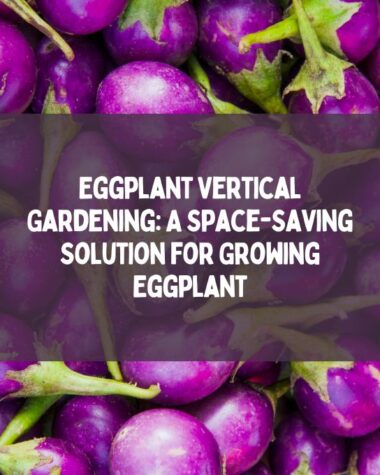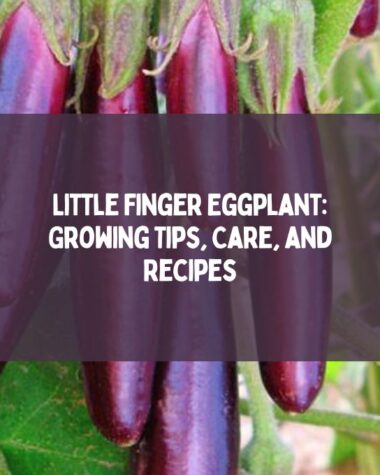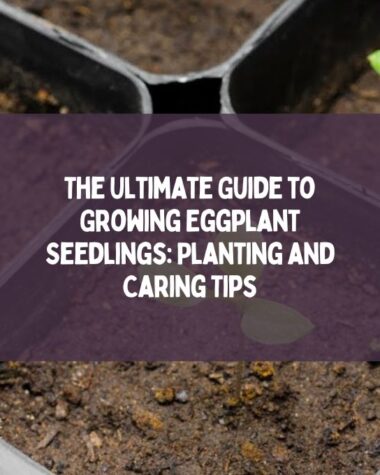Grow eggplants on a trellis, start by selecting a trellis material that can support the weight of the plants and fruit. Choose a sunny location in the garden and prepare the soil with organic matter and fertilizer. Plant the eggplants at the base of the trellis and provide support for the stems.
Prune the plants as needed and remove any dead plant material. Water the plants regularly, but avoid getting the leaves and fruit wet to reduce the risk of disease. Finally, harvest the fruit when it is ripe and enjoy the delicious bounty of your eggplant trellis garden!
Eggplants are a warm-weather crop that requires support as they grow. Trellising is a popular technique that gardeners use to support eggplants because it keeps the fruits off the ground and improves air circulation around the plants.
This article will explain how to support the eggplant on a trellis.
Let’s take a look.
Steps to Support Eggplants on a Trellis

Here are the steps to follow to successfully grow eggplants on a trellis:
1. Choose the right variety
There are many different eggplant varieties to choose from, but not all of them are suitable for trellising. Choose a variety like Chinese eggplant, fairytale eggplant, Italian eggplant, or Indian eggplant that has a strong stem and can support the weight of the fruit.
2. Prepare the soil
Eggplants thrive in well-draining soil that is rich in organic matter. Amend the soil with compost or well-rotted manure and ensure that it has a pH of between 5.5 and 6.8.
3. Install the trellis
Choose a sturdy trellis that is at least 5 feet tall and 2 feet wide. Install it securely into the ground or into a container.
4. Plant the seedlings
Plant the eggplant seedlings at the base of the trellis. Space them 18–24 inches apart.
Related Reading
- Top 5 Eggplant Growing Problems (and How to Fix Them)
- The Ultimate Guide to Growing Eggplant Seedlings: Planting and Caring Tips
- When to Harvest Eggplants – Find Out the Best Time to Pick Your Eggplants!
- How To Grow Aubergine From Seed?
5. Provide support
As the eggplants grow, gently tie them to the trellis with soft twine. Make sure not to tie them too tightly, as this can damage the stems.
6. Water and fertilize
Eggplants require consistent moisture, so water them deeply once or twice a week. Fertilize them with a balanced fertilizer once a month.
7. Prune and train
As the eggplants grow, prune off any lateral shoots that emerge from the main stem. This will encourage the plant to focus its energy on fruit production. Train the main stem up the trellis as it grows, using soft twine to tie it to the trellis if necessary.
8. Harvest the fruit
Once the eggplants are mature, harvest them by cutting them from the stem with a sharp knife. Be sure to harvest them before they become overripe, as this will encourage the plant to produce more fruit.
Types of Trellis For Growing Eggplants

The type of trellis you choose will depend on the space you have available and your personal preference.
Here are some types of trellises that can be used to support eggplants:
- A-frame trellis: This is a simple trellis made by constructing two vertical poles and connecting them with a horizontal beam at the top to form an A shape.
- Teepee trellis: This is a trellis made by constructing several vertical poles in a circle and tying them together at the top to form a cone shape.
- Cattle panel trellis: This is a trellis made by using a metal panel with rectangular holes. The panel is supported by two vertical poles and can be attached to stakes.
- String trellis: This is a trellis made by attaching a series of strings horizontally to a set of vertical poles.
- Tuteur Trellis: A tuteur trellis is a tall, pyramid-shaped structure that can be used to support multiple eggplant plants.
- Hog Panel Trellis: This trellis system involves using a hog panel, which is a type of wire mesh, to provide support for the eggplant plants.
- Wood Lattice Trellis: This trellis system involves using wooden slats to create a lattice-like structure to provide support for the eggplant plants.
- Bamboo Trellis: This trellis system involves using bamboo poles or stakes to create a support structure for the eggplant plants.
- Taut-Wire Trellis: This trellis system involves stretching a wire between two posts and attaching it to smaller vertical stakes placed along the row of eggplants.
These are just a few examples of the types of trellises that can be used to support eggplants.
Pros and Cons of Using Trellis For Eggplants
Here are some of the pros and cons of using a trellis to support eggplants:
Pros:
- Increased Yield: By supporting the eggplant plants with a trellis, the plants are able to grow upright and produce more fruit, resulting in a higher yield.
- Better Air Circulation: A trellis allows for better air circulation around the plants, which can reduce the risk of fungal diseases and promote healthy plant growth.
- Easy Harvesting: When the eggplant plants are supported by a trellis, the fruit is easier to see and harvest, which can save time and reduce the risk of damage to the plants.
- Space-Saving: A trellis allows you to grow eggplants vertically, which can save space in your garden and make it easier to grow more plants in a smaller area.
Cons:
- Initial Cost: Depending on the type of trellis you choose, there may be an initial cost associated with purchasing or building the trellis.
- Maintenance: A trellis requires regular maintenance, including pruning and tying up the plants to keep them growing upright.
- Limited Variety: Some eggplant varieties may not be well-suited for trellising, which can limit the types of eggplants you can grow.
- Skill and Experience: Proper trellising requires skill and experience, and inexperienced gardeners may struggle to properly train and support their eggplant plants.
With the right trellis system and proper maintenance, your eggplants can grow healthy and produce a bountiful harvest.
Keep Eggplant Uprights On Trellis
Keeping eggplants upright on a trellis is essential to ensuring healthy plant growth and optimal fruit production.
As the eggplant plants grow, they can become heavy, which can cause the fruit to touch the ground and become damaged. By using a trellis, you can keep the stems and fruit off the ground, allowing for better air circulation and a bountiful harvest.
Other Support Types for Eggplants

In addition to trellises, there are other types of support that can be used to keep eggplants upright and healthy.
Here are a few:
1. Cages
Eggplant cages are typically made of metal or plastic and are designed to surround the plant and support the stems as they grow. Cages are a good option for gardeners who prefer a low-maintenance support system that requires little tying or pruning.
2. Tomato Cage Trellis
This trellis system involves using a tomato cage to support the eggplant plants. The cages can be made of wire or bamboo and are placed over each plant.
The eggplant plant grows up through the center of the cage, which provides support for the stems and fruit. This trellis system is easy to set up and works well for medium-sized eggplant varieties.
3. Stakes
Eggplant stakes are vertical posts that are inserted into the ground near the plant and used to tie up the stems as they grow. Stakes can be made of wood, bamboo, or metal and are a good option for gardeners who want a simple and inexpensive support system.
How many eggplants can be supported on a single trellis?
The number of eggplants that can be supported on a single trellis depends on a few factors, such as the size and spacing of the trellis and the skill and experience of the gardener.
But a trellis can support 2-3 eggplant plants per linear foot. However, it’s important to monitor the plants and adjust the space or support as needed to ensure healthy growth.
Is a trellis compulsory for eggplant growth?
No, a trellis is not compulsory for eggplant growth, but it can be beneficial in many ways. Eggplants can be grown without a trellis and will still produce fruit, but the use of a trellis can improve plant health and increase yields.
When eggplants are grown without support, they can become heavy, causing the fruit to touch the ground and increasing the risk of damage or disease. A trellis can also save space in the garden.
Related Reading
- Tomato Stakes Vs Cages: Which is Better for Support?
- Japanese Cucumber Info: How to Grow Japanese Cucumber From Seed?
- How to Grow Pumpkins in Pots?
- 5 Reasons Why Zucchini Blossoms Fall Off: A Comprehensive Guide
Conclusion
Growing eggplants on a trellis can be a great way to improve plant health, increase yields, and save space in the garden. It also helps reduce the damage caused by pests and diseases.
With proper care, you can also grow healthy eggplant.
Happy gardening!







